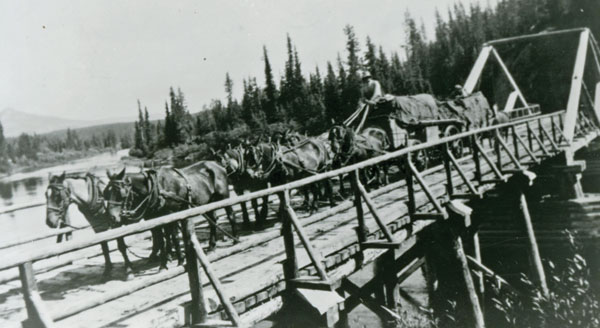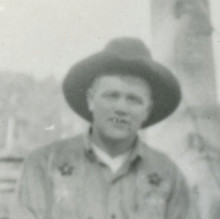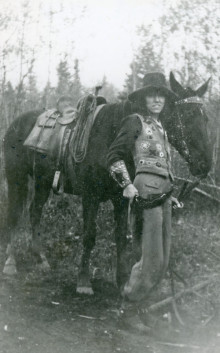
Earl Buck drove freight wagons, rodeoed and wrote cowboy poetry. His wife Claire was a horse packer, drove cattle, and together they built their ranch along British Columbia’s northern fringe.
Originally from Saskatchewan they believed in self-help and self-sufficiency. Sometimes they lived in soddies, store houses, log cabins or dugouts. Success came from long hours, hard work and as Earl said: “A good sense of humour about the vagaries of life”.
We were winter-feeding their cattle on a -20° F day in 1984. Earl’s matched team of Belgians pawed the ground anxious to be off. Adjusting their harness, his hands were nimble but weathered and blunt from over 50 years of driving teams in summer sun and winter blizzards. He pulled his life-scarred Stetson down against the wind and I buried my face in my scarf. The team leaned into the load and the runners on the sleigh crunched the hard packed snow. Through steam from their backs and our breath he explained that his father, Henry Buck settled near Abbey, Sask., in 1898 and built a farm 15 miles south, along with a ranch in the Great Sand Hills District. Near a place called the Dipping Vat, Earl first started to rodeo.
The Depression brought hard times to the Buck family and an uncle wrote one of the shortest letters as a result:

Dear Billie,
Your land is broke,
My leg is broke, I am broke.
So long,
Joe Buck.
Joe’s letter summed up conditions in late 1929, so Earl, his two brothers Elton and Myrell, and his future brother-in-law Bud Shaver, headed off to Fort St. James, B.C. They homesteaded in a small log cabin near Stuart Lake. Earl had some pack horses and a few head of cattle and to make some cash, they all cut firewood for $6 a cord.
Earl began to promote rodeos of his own, 20 in all, starting in the early 1930s. He organized the largest rodeo in Vanderhoof, B.C., using bucking horses from Williams Lake, and he imported some Brahma bulls as well. That was the first time Brahmas were used that far north in B.C., for a competition. Known as a competent trick rider and shooter, he once won five rough stock events in a row at a local rodeo.
About this time a wagon freighter named Bob McCorkell hired Earl and Bud to haul winter supplies to the gold mining camps at Manson Creek, 140 miles north of Fort St. James. Of the many freight trips that Earl made during winter months, one was especially clear in his memory.
They were to haul in supplies for a mining operation, set up food caches every 20 miles and break trail to each camp using sleighs and horse teams. On the steep stretches the teams had to be doubled up and when an open creek was crossed, a log bridge had to be built. Camp had to be set up each night and horse stalls shoveled out of the snow.
When the thermometer hit bottom the horses had to be double-blanketed while pine trees snapped like rifle shots. Snow depths varied between three to five feet and sometimes the horses had to be walked all night to keep from freezing. When the snow reached four feet deep, they had to break trail with a team dragging doubletrees, since each sleigh carried nearly two tons of supplies. Earl and the other freighters slept in blankets under a fly with a fire in front for warmth and if the wind switched direction, they were choked out with smoke. To add to their misery, the supply owner had underestimated the amount of food needed and several times they nearly ran out of provisions. To supplement their food they hunted whatever they could find.

Earl remembered a strange occurrence on a really cold night that trip. One of the freighters had a dog that was usually quiet, but on that particular evening he began to howl for no apparent reason. Two days later news came to the camp that the dog owner’s father had been killed in an accident back at the Fort, just about the time the dog had started to howl. More than cold weather could give you the shivers in that country.
Shoveling through four feet of snow and ice on the trail was common. If they dug down 10 feet without striking solid ground they packed the snow instead. One of the major problems of sleigh freighting was the build-up of snow crust that could cut the horses’ legs. A cross-cut saw was used to slice the crust into blocks so the trail could be shoveled out. When the horse grain ran out at -30° F, Earl waded across a creek and snowshoed a day to retrieve oats from a feed cache. Arriving back in camp, he found the entire crew was snow blind.
On another trip into Manson Creek, Earl met a lost miner walking out over Baldy Mountain who would have died if he had not been picked up and cared for. Earl also met a group coming from Slate Creek Mine; after two weeks on the trail they were out of supplies and nearly frozen to death, so Earl transported them all out to the Fort.
During one record-breaking winter at their ranch, the Bucks endured six weeks of -40° F to -60° F and some cows froze their lungs. Earl’s daughter Sharon nearly froze to death when she was riding in the back of the wagon full of the orphaned calves. The calves all died but insulated her from the cold. On one cattle drive, the sky turned black as a storm hit and the thermometer plunged to -60° F. The Buck family, including a one-year-old baby, was forced to camp out without a tent.
Earl and Claire both loved the North Country but Earl said that ranching there was never easy. Wolves killed stock and were protected by the game department, rustlers always took their toll and some hunters couldn’t tell the difference between a moose and a Hereford. You had to know how to take care of trouble yourself. They travelled armed because the police were a long ways off. Even so, Earl and Claire kept on ranching until they passed away. He used to say, “We have to keep going because that’s all we know—horses, hay and cattle.”
